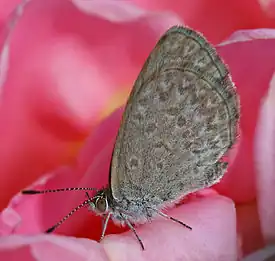| Indigofera australis | |
|---|---|
 | |
| Scientific classification | |
| Kingdom: | Plantae |
| Clade: | Tracheophytes |
| Clade: | Angiosperms |
| Clade: | Eudicots |
| Clade: | Rosids |
| Order: | Fabales |
| Family: | Fabaceae |
| Subfamily: | Faboideae |
| Genus: | Indigofera |
| Species: | I. australis |
| Binomial name | |
| Indigofera australis | |
 | |
| Synonyms | |
Indigofera australis, the Australian indigo or Austral indigo, is an attractive species of leguminous shrub in the genus Indigofera (family Fabaceae).[1] The genus name Indigofera is Neo-Latin for "bearing Indigo" (Indigo is a purple dye originally obtained from some Indigofera species). Australis, from the Latin, means not “Australian” but "southern", referring to the geographical distribution of the species.[2]
Description
Its natural habit is upright, to 2 m (7 ft) high,[3] with flexible stems. The leaves are pinnate, openly spaced on the stems, around 10 cm long and velvety smooth to the touch. The flower color is unusual, ranging through soft purple hues, often pinkish and a change from other species flowering at the same time. The flowers are smooth, in short spires in the leaf axils, freely produced and showy, outlining the curves of the stems. They may open at any time from July and may continue till November in a cool spring. It can regrow and sucker from rootstocks and lateral roots after fire.[4]
Distribution
A very common and widespread species in Australia, Indigofera australis grows in a variety of different habitats, mainly open woodland and eucalypt forest, but also in desert and in the margins of rainforest. It is widespread in southern Australia from the southeastern Western Australia to northeastern Queensland.[3]
Habitat value
It is an excellent habitat plant for wildlife. Like many plants in the pea family, Indigofera australis is nitrogen fixing.[2] The flowers are a pollen and nectar source for many native insects, including bees and wasps. The plant is a useful food plant for butterfly larvae (caterpillars):[5]
- Freyeria trochylus – "Grass Jewel"
- Eurema hecabe – "Common Grass Yellow"
- Lampides boeticus – "Long-tailed Pea Blue"
- Zizina labradus – "Common Grass-blue"
Uses
The attractive flowers, and the plants adaptability to grow in different situations make it suitable as an ornamental plant in Australia. However, it may become invasive.[6]
First Nations Australians are said to have crushed the leaves and added these to water to kill or stun fish and eels.[7] The leaves and stems produce yellow-fawn dye with alum as mordant.

 Australian indigo growing at Eastwood, New South Wales
Australian indigo growing at Eastwood, New South Wales
References
- ↑ Les Robinson - Field Guide to the Native Plants of Sydney, ISBN 978-0-7318-1211-0 page 82
- 1 2 "Virtual Herbarium: South West Slopes Revegetation Guide: Indigofera australis". Charles Sturt University. Retrieved 19 August 2023.
- 1 2 Peter Gordon Wilson. "Indigofera australis". PlantNet - New South Wales Flora Online. NSW Government. Retrieved 19 August 2023.
- ↑ "Indigofera australis" (PDF). Communities in Landscapes. Greening Australia. Retrieved 19 August 2023.
- ↑ "Indigofera australis". Plants to Plant. Save Our Waterways. Retrieved 19 August 2023.
- ↑ Don Burke. "Trees and other plants to avoid". Fact Sheets. Burkes Back Yard. Retrieved 19 August 2023.
- ↑ "Information about Australia's Flora: Aboriginal Plant Use in SE Australia: 13 Austral Indigo". Australian National Botanic Gardens. Retrieved 1 October 2019.
External links
- Indigofera australis on Plant Net (retrieved September 18, 2009)
- Indigofera australis